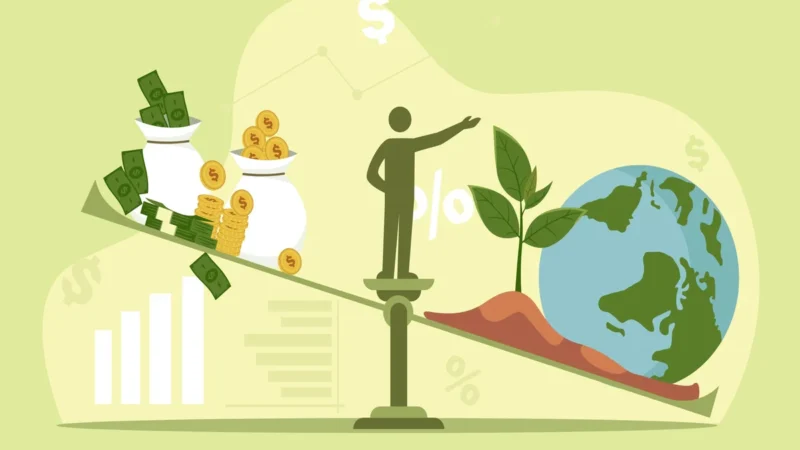Benefits of Circular Economy: Promoting Sustainable Development

In recent years, the concept of a circular economy has gained significant attention as a transformative approach to sustainable development. Unlike the traditional linear economy, which follows a “take-make-dispose” model, the circular economy aims to minimize waste, maximize resource efficiency, and foster economic growth while preserving the environment and promoting social equity. This article explores the various benefits of adopting a circular economy approach.
Reduced Waste Generation and Resource Conservation:
Circular economy strategies prioritize waste reduction and resource conservation. By shifting from a linear model to a circular one, products and materials are designed, produced, and used in a way that extends their lifecycle. This reduces the amount of waste generated, conserves natural resources, and mitigates the environmental impact of extraction and production processes.
Enhanced Resource Efficiency:
Circular economy practices focus on optimizing resource use through strategies such as recycling, remanufacturing, and refurbishment. By adopting these practices, businesses and industries can extract more value from existing resources, reduce their reliance on virgin materials, and minimize the energy and water consumption associated with extraction and production.
Economic Growth and Job Creation:
Circular economy initiatives can drive economic growth by fostering innovation, stimulating new business models, and creating job opportunities. The shift towards a circular economy can open up avenues for entrepreneurship, as new markets for recycling, repair, and re-manufacturing emerge. This transition can also lead to cost savings for businesses through improved resource management and reduced waste disposal expenses.
Environmental Preservation and Climate Change Mitigation:
The circular economy supports environmental preservation by reducing pollution and minimizing the extraction of finite resources. By promoting the reuse and recycling of materials, circular practices reduce the need for resource-intensive processes and lower greenhouse gas emissions. This contributes to climate change mitigation efforts and helps to preserve ecosystems and biodiversity.
Improved Product Design and Innovation:
Circular economy principles encourage the design of products and systems that are durable, repairable, and recyclable. By considering the entire lifecycle of a product, from its creation to its disposal, designers can optimize resource use, reduce waste, and enhance the overall quality and longevity of products. This focus on innovation drives creativity and leads to the development of more sustainable and circular solutions.
Social Equity and Inclusion:
Circular economy strategies emphasize the importance of social equity and inclusion by promoting fair and inclusive economic systems. This approach encourages the creation of jobs in local communities, supports social enterprises, and promotes equitable access to resources. By involving various stakeholders, including marginalized communities, the circular economy can help address social and economic disparities.
Key Takeaways:
The benefits of embracing a circular economy are numerous and diverse. By transitioning from a linear model to a circular one, societies can reduce waste, enhance resource efficiency, foster economic growth, preserve the environment, and promote social equity. Through innovative practices, collaboration among stakeholders, and supportive policies, the circular economy offers a promising pathway towards a more sustainable and prosperous future.
FAQs about Benefits of Circular Economy
What is a circular economy, and why is it beneficial?
A circular economy is an economic model that aims to minimize waste and maximize resource efficiency. It promotes the reuse, recycling, and remanufacturing of products and materials, reducing environmental impact and preserving resources for future generations. Adopting a circular economy approach brings benefits such as waste reduction, economic growth, environmental preservation, and social equity.
How does the circular economy reduce waste?
The circular economy focuses on reducing waste by designing products and systems that promote reuse, recycling, and refurbishment. By extending the lifecycle of products, materials are kept in circulation for longer, minimizing waste generation and the need for disposal. This helps conserve resources and reduce the environmental impact associated with waste management.
How does the circular economy contribute to resource efficiency?
Circular economy practices optimize resource use by prioritizing recycling, remanufacturing, and other strategies. By extracting more value from existing resources, businesses reduce their dependence on virgin materials, conserve energy and water, and minimize the environmental footprint of resource extraction and production processes.
Can the circular economy drive economic growth?
Yes, the circular economy can stimulate economic growth. It promotes innovation and the development of new business models, leading to job creation and entrepreneurship opportunities. By improving resource management, businesses can achieve cost savings, and emerging sectors such as recycling and remanufacturing can create additional employment opportunities.
How does the circular economy help with environmental preservation?
The circular economy contributes to environmental preservation by reducing pollution and conserving natural resources. Through practices like recycling and sustainable production methods, the circular economy minimizes the extraction of finite resources and decreases greenhouse gas emissions. This aids in mitigating climate change, preserving ecosystems, and protecting biodiversity.
What role does product design play in the circular economy?
Product design is crucial in the circular economy as it influences the entire lifecycle of a product. Circular design principles emphasize durability, reparability, and recyclability. By creating products that can be easily repaired, upgraded, or recycled, designers contribute to waste reduction, resource efficiency, and the development of more sustainable and circular solutions.


